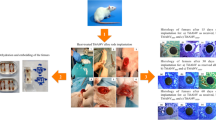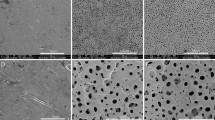Abstract
To achieve osteoconductivity, Ti–0.5Pt and Ti–6Al–4V–0.5Pt alloys were hydrothermally treated at 200°C in 10 mmol/l CaCl2 aqueous solution for 24 h (HT-treatment). We conducted histological investigations of the HT-treated materials by using Wistar strain rats (SD rats) to evaluate the usefulness of the treatment. To measure the bone bond strength, the specimens were implanted in the tibia of SD rats, and a pull-out test was conducted. From the early postoperative stages, direct bone contact was obtained for the HT-treated implants. Within 1–4 weeks of implantation, the bone contact ratios and bone bond strengths of the HT-treated implants were higher than those of the non-treated implants. The Ti–0.5Pt and Ti–6Al–4V–0.5Pt alloys with HT-treatment showed the potential to develop a new implant with a high bone bond strength and rapid osteoconduction.









Similar content being viewed by others
References
LeGeros RZ, Craig RG. Strategies to affect bone remodeling: osteointegration. J Bone Min Res. 1993;8:583–96.
Daculsi G, LeGeros RZ, Deudon C. Scanning and transmission electron microscopy, and electron probe analysis of the interface between implants and host bone. Scan Micr. 1990;4:309–14.
Hirai H, Okumura A, Goto M, Katsuki T. Histologic study of the bone adjacent to titanium bone screws used for mandibular fracture treatment. J Oral Maxillofac Surg. 2001;59:531–7. doi:10.1053/joms.2001.22686.
Lum LB, Beirne OR, Curtis DA. Histlogical evaluation of HA-coated vs. uncoated titanium blade implants in delayed and immediately loaded applications. Int J Oral Maxillofac Implants. 1991;6:456–62.
Szmukler-Moncler S, Salama H, Reingewirta Y, Dubruille JH. Timing of loading and effect of micromotion on bone-dental implant interface: review of experimental literature. J Biomed Master Res. 1998;43:192–203. doi:10.1002/(SICI)1097-4636(199822)43:2<192::AID-JBM14>3.0.CO;2-K.
Hench LL. Bioceramics: from concept to clinic. J Am Ceram Soc. 1991;74:1487–510. doi:10.1111/j.1151-2916.1991.tb07132.x.
Kokubo T. A/W glass-ceramic: processing and properties. In: Hench LL, Wilson J, editors. An introduction to bioceramics. Singapore: World Scientific; 1993. p. 75–88.
Neo M, Nakamura T, Yamamuro T, Ohtsuki C, Kokubo T. Apatite formation on three kinds of bioactive material at an early stage in vivo: a comparative study by transmission electron microscopy. J Biomed Mater Res. 1993;27:999–1066. doi:10.1002/jbm.820270805.
Kokubo T, Miyaji F, Kim HM, Nakamura T. Spontaneous apatite formation on chemically surface treated Ti. J Am Ceram Soc. 1996;79:1127–9. doi:10.1111/j.1151-2916.1996.tb08561.x.
Kim HM, Miyaji F, Kokubo T. Effect of heat treatment on apatite-forming ability of Ti metal induced by alkali treatment. J Mater Sci: Mater Med. 1997;8:341–7. doi:10.1023/A:1018524731409.
Nishiguchi S, Nakamura T, Kobayashi M, Kim HM, Miyaji F, Kokubo T. The effect of heat treatrment on bone-bonding ability of alkali-treated titanium. Biomaterials. 1990;20:491–500. doi:10.1016/S0142-9612(98)90203-4.
Nishiguchi S, Kato H, Fujita H, Kim HM, Miyaji F, Kokubo T, et al. Enhancement of bone-bonding strengths of titanium alloy implants by alkali and heat treatments. J Biomed Mater Res Appl Biomater. 1999;48:689–96. doi:10.1002/(SICI)1097-4636(1999)48:5<689::AID-JBM13>3.0.CO;2-C.
Nakagawa M, Zhang L, Udoh K, Matsuya S, Ishikawa K. Effect of hydrothermal treatment with CaCl2 solution on surface property and cell response of titanium implants. J Mater Sci: Mater Med. 2005;16:985–91. doi:10.1007/s10856-005-4753-0.
Kim HM, Miyaji F, Kokubo T. Effect of heat treatment on apatite-forming ability of Ti metal induced by alkali treatment. J Mater Sci: Mater Med. 1997;8:341–7. doi:10.1023/A:1018524731409.
Toumelin-chemla F, Rouelle F, Burdairon G. Corrosive properties of fluoride-containing odontologic gels against titanium. J Dentistry. 1996;24:109–15. doi:10.1016/0300-5712(95)00033-X.
Strietzel R, Hosch A, Kalbfleisch H, Buch D. In vitro corrosion of titanium. Biomaterials. 1998;19:1495–9. doi:10.1016/S0142-9612(98)00065-9.
Nakagawa M, Matsuya S, Shiraishi T, Ohta M. Effect of fluoride concentration and pH on corrosion behavior of titanium for dental use. J Dent Res. 1999;78:1568–72. doi:10.1177/00220345990780091201.
Kaneko K, Yokoyama K, Moriyama K, Asaoka K, Sakai J, Nagimo M. Delayed fracture of beta titanium orthodontic wire in fluoride aqueous solutions. Biomaterials. 2003;24:2113–20. doi:10.1016/S0142-9612(02)00642-7.
Schiff N, Grosgogeat B, Lissac M, Dalard F. Influence of fluoride content and pH on the corrosion resistance of titanium and its alloys. Biomaterials. 2002;23:1995–2002. doi:10.1016/S0142-9612(01)00328-3.
Huang HH. Effect of fluoride concentration and elastic tensile strain on the corrosion resistance of commercially pure titanium. Biomaterials. 2002;23:59–63. doi:10.1016/S0142-9612(01)00079-5.
Matono Y, Nakagawa M, Matsuya S, Ishikawa K, Terada Y. Corrosion behavior of pure titanium and titanium alloys in various concentrations of acidulated phosphate fluoride (APF) solutions. Dent Mater J. 2006;25:104–12.
Nakagawa M, Matono Y, Matsuya S, Udoh K, Ishikawa K. The effect of Pt and Pd alloying additions on the corrosion behavior of titanium in fluoride-containing environment. Biomaterials. 2005;26:2239–46. doi:10.1016/j.biomaterials.2004.07.022.
Nakagawa M, Matsuya S, Udoh K. Corrosion behavior of pure titanium and titanium alloys in fluoride containing solutions. Dent Mater J. 2001;20:305–14.
Nakagawa M, Matsuya S, Udoh K. Effect of fluoride and dissolved oxygen concentrations on the corrosion behavior of pure titanium and titanium alloys. Dent Mater J. 2002;21:83–92.
Yamazoe J, Nakagawa M, Matono Y, Takeuchi A, Ishikawa K. The development of Ti alloys for dental implant with high corrosion resistance and mechanical strength. J Dent Mat. 2007;26:260–7. doi:10.4012/dmj.26.260.
Ayukawa Y, Takeshita F, Inoue T, Yoshinari M, Ohtsuka Y, Murai K, et al. An ultrastructural study of the bone-titanium interface using pure titanium-coated plastic and titanium rod implants. Acta Histochemica et Cytochemica. 1996;29:234–54.
Ayukawa Y, Okamura A, Koyano K. Simvastatin promotes osteogenesis around titanium implants. Clin Oral Implant Res. 2004;15:346–50. doi:10.1046/j.1600-0501.2003.01015.x.
Mano T, Ueyama Y, Ishikawa K, Matsumura T, Suzuki K. Initial tissue response to a titanium implant coated with apatite at room temperature using a blast coating method. Biomaterials. 2002;23:1931–6. doi:10.1016/S0142-9612(01)00319-2.
Takadama H, Kim HM, Kokubo T, Nakamura T. An X-ray photoelectron spectroscopy study of the process of apatite formation on bioactive titanium metal. J Biomed Mater Res. 2001;55:185–93. doi:10.1002/1097-4636(200105)55:2<185::AID-JBM1005>3.0.CO;2-P.
Kim HM, Himeno T, Kawashita M, Lee JH, Kokubo T, Nakamura T. Surface potential change in bioactive titanium metal during the process of apatite formation in simulated body fluid. J Biomed Mater Res. 2003;67:1305–9. doi:10.1002/jbm.a.20039.
Gottlander M, Albrektsson T. Histomorphometric studies of hydroxyapatite-coated and uncoated CP titanium threaded implants in bone. Int J Oral Maxilofac Implants. 1991;6:399–404.
Matsui Y, Ohno K, Michi KI, Yamagata K. Experimental study of high-viscosity flame-sprayed hydroxyapatite coated and noncoated titanium implants. Int J Oral Maxillofac Implants. 1994;9:397–404.
Nishiguchi S, Kato H, Fujita H, Oka M, Kim HM, Kokubo T, et al. Titanium metals form direct bonding to bone after alkali and heat treatments. Biomaterials. 2001;22:2525–33. doi:10.1016/S0142-9612(00)00443-9.
Acknowledgments
This study was supported by a Grant-in Aid for Scientific Research (20592301) from the Ministry of Education, Culture, Sports, Science and Technology, Japan.
Author information
Authors and Affiliations
Corresponding author
Rights and permissions
About this article
Cite this article
Nakagawa, M., Yamazoe, J. Effect of CaCl2 hydrothermal treatment on the bone bond strength and osteoconductivity of Ti–0.5Pt and Ti–6Al–4V–0.5Pt alloy implants. J Mater Sci: Mater Med 20, 2295–2303 (2009). https://doi.org/10.1007/s10856-009-3799-9
Received:
Accepted:
Published:
Issue Date:
DOI: https://doi.org/10.1007/s10856-009-3799-9




